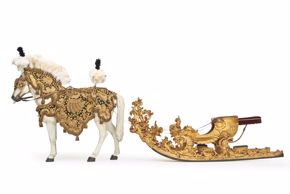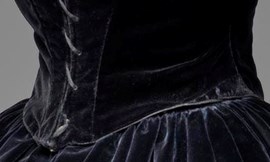Habsburg Chic August 19, 2015

Attributed to Balthasar Moll, Vienna Court Carousel Sleigh, c. 1740/50, wood, gold, and velvet, Imperial Carriage Museum, Vienna.
Italian (probably Milanese), All’Antica Burgonet of Archduke Ferdinand II of Tyrol, c. 1560, blued and embossed iron, gold, and silver, Kunsthistorisches Museum, Vienna.
Roman, An Antonine Prince as Mercury, AD 150–175, nicolo, pale blue on brown layer; mounted as a pendant in an enameled gold mount with rubies and diamonds, Kunsthistorisches Museum, Vienna, Collection of Greek and Roman Antiquities.
Jan Thomas, Gundakar, Prince Dietrichstein (detail), c. 1667, oil on canvas, Kunsthistorisches Museum, Vienna.
Diego Rodriguez de Silva y Velázquez, Infanta Maria Theresa, c. 1652/53, oil on canvas, Kunsthistorisches Museum, Vienna.
Jan Thomas, Emperor Leopold I and Infanta Margaret Theresa, 1667, oil on copper, Kunsthistorisches Museum, Vienna.
Andreas Möller, Maria Theresa as a Child, c. 1727, oil on canvas, Kunsthistorisches Museum, Vienna.
Ceremonial Garment of a Hungarian Magnate, Hungarian, c. 1865, silk, velvet, fur, gold passementerie, gilded silver, enamel, mother-of-pearl, turquoise, and plumes; boots: leather; saber: steel, metal, velvet, gemstones, and leather; Kunsthistorisches Museum, Vienna.
Dress Coat for Lackeys and Coachmen, Austrian, 19th century, cloth, silk, and passementerie edging, Kunsthistorisches Museum, Vienna.
In the style of Charles F. Worth, Black Velvet Dress Belonging to Empress Elisabeth, c. 1860–65, velvet and silk, Kunsthistorisches Museum, Vienna, Court Wardrobe Collection.
The Habsburg Dynasty loved lavish and ostentatious fashion. Browse the sumptuous materials, intense detailing, and bold silhouettes in these objects and paintings from Habsburg Splendor: Masterpieces from Vienna’s Imperial Collections.
Take a look at close-up details of the artworks below, and look through the slideshow to see the full images.
- Designed for a royal wedding, this imposing sleigh harness is decorated with rich velvet and an ostrich-feather crest. Some 350 golden bells help warn of the sleigh’s muffled approach on soft snow.
 (1)
(1)
- Through a combination of gold, silver, and iron, figures of ancient Greece and Rome adorn this ceremonial helmet.
 (2)
(2)
- Symbols such as a wing and a herald’s staff indicate that this intricately carved cameo is a tiny portrait of the Roman god Mercury.
 (3)
(3)
- Adorned with flowers, twigs, and silver embroidery, both Prince Dietrichstein and his horse wear the color green to represent elements of the Earth. His larger-than-life hat is intricately detailed with jewels and feathers.
 (4)
(4)
- Infanta Maria Theresa of Spain is dressed in a close-fitting bodice, false sleeves, and a hoop skirt called a guardainfante. Many versions of this portrait were sent across the empire to show that the young princess was ready to be married.
 (5)
(5)
- For their marriage portraits, Emperor Leopold I and his niece, Infanta Margaret Theresa of Spain, posed in dramatic Baroque costumes inspired by La Galatea, a popular musical from the early days of Viennese opera.
 (6)
(6)
- Exemplifying the court’s ultrafeminine styles, the satin gown of future sovereign Maria Theresa is lined with lace, gold, and pearls. Behind her, a crown of fur and velvet hints at her imminent role as Holy Roman Empress.
 (7)
(7)
- The ceremonial garments of Hungarian magnates demonstrate privilege and opulence with fur, mother-of-pearl, and a sword sheathed in blue velvet.
 (8)
(8)
- Court etiquette dictated that expensive servants' attire, such as this calf-length ceremonial coat worn by a coachman, enhanced the status of a house.
 (9)
(9)
- Known as a fashion icon and trendsetter, Empress Elisabeth radiated imperial luxury in this simple, black gown. The choice of fabric was deliberate: velvet symbolizes royalty.
 (10)
(10)
See more examples of extravagant fashions and exquisite artworks in the Habsburg Splendor exhibition, on view only through September 13.





